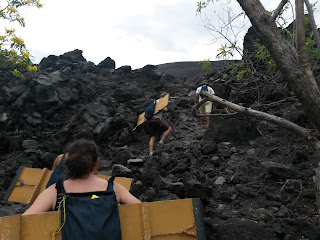 Ironically, as I write this I am in fact rather sick. No, not Malaria... nor dengue... nope not Zika. No there is not a gigantic worm crawling out of my eye socket.... I have a cold. Yesterday I went to a "Farmacia" and spent about $1 on some kind of cold pills recommended by the employee there and I'm feeling a lot better now. Pharmacies in Nicaragua are very common and easy to find, even in the smallest communities. Furthermore they are very inexpensive. They sell the same medications you are used to, even the same brand names at a fraction of the cost you would pay in north america. The medicines they sell you are just as strong, they are not different. Some of the local brand names are in fact more effective.
Ironically, as I write this I am in fact rather sick. No, not Malaria... nor dengue... nope not Zika. No there is not a gigantic worm crawling out of my eye socket.... I have a cold. Yesterday I went to a "Farmacia" and spent about $1 on some kind of cold pills recommended by the employee there and I'm feeling a lot better now. Pharmacies in Nicaragua are very common and easy to find, even in the smallest communities. Furthermore they are very inexpensive. They sell the same medications you are used to, even the same brand names at a fraction of the cost you would pay in north america. The medicines they sell you are just as strong, they are not different. Some of the local brand names are in fact more effective.Now, lets say its something more serious and you need to see a doctor. Being from Canada I'm really not used to the Idea of paying for medical services, but I understand that in the US the thinking is that "you get what you pay for" in terms of medical treatment. Nicaragua has both private and public health services. There are private doctors, hospitals, and clinics that charge a wide range of prices for their services. There are also public clinics and hospitals which are a bit more commonplace. The public health services in Nicaragua are 100% free, sometimes including the medications they prescribe you. This includes foreigners. On my first trip I spent a ton of money on health insurance only to find out the doctors here are free, no one told me that. You as a foreigner can in fact come to Nicaragua, walk into the health center and be treated without paying a single Cordoba and no one will look at you funny (However you do need to speak Spanish or bring an interpreter).
Many people coming from countries where it is necessary to pay for medical treatment tend to feel that paying more will result in a better treatment. Now, its not my place to make medical decisions for people, that is up to you. But from my experience and those of friends and family, the idea that "you get what you pay for" does not apply in Nicaragua. Many private doctors have a bad reputation here in Nicaragua, and some of the most expensive and prestigious private hospitals have a long track record of botched operations. The doctors in the public health centers are often more experienced, as they deal with anyone and everyone that comes to them. The clients of the private doctors are almost exclusively wealthy tourists that come to them once in a blue moon. Another myth is that the public health centers are "filthy" and "disgusting". This might be true of one or two hospitals but they are the exception not the rule. Most are clean, efficient, and well equipped.
I also was quite worried about getting all the "injections" that I needed before coming to Nicaragua. I thought that I had to have certain vaccinations or I wouldn't be allowed off the plane when I arrived, and as such had a printout of my vaccination history. This wasn't true... and honestly I wasted a lot of time worrying about taking care of medical things before leaving for Nicaragua. I also had that mistaken attitude that Nicaraguan doctors were somehow inferior and couldn't help me if I got sick down here. In reality, Nicaraguan doctors know a lot about Nicaraguan illnesses. In my opinion, one is better off to wait until they are here and ask a local if they have some health problems. An illness that is common and easily treated in Nicaragua might be unheard of and have no treatment available in Canada or the US. Parasites for example are super easy to take care of in Nicaragua. The pills are available everywhere and they are dirt cheap, and they do work.
These are just my opinions, your decisions about health matters should not be based on the ideas of any one person, but hopefully this information will help anyone coming down here to make an informed decision about what kind of medical care to choose, and maybe address some fears that people may have before making a trip. Good health to you!










